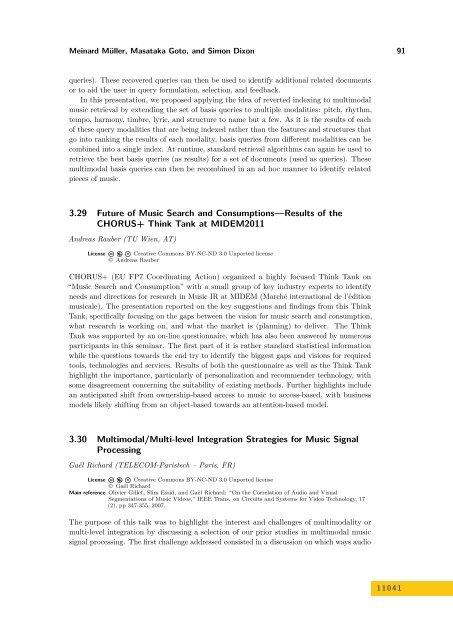Volume 1, Issue 1, January 2011 - DROPS - Schloss Dagstuhl
Volume 1, Issue 1, January 2011 - DROPS - Schloss Dagstuhl
Volume 1, Issue 1, January 2011 - DROPS - Schloss Dagstuhl
You also want an ePaper? Increase the reach of your titles
YUMPU automatically turns print PDFs into web optimized ePapers that Google loves.
Meinard Müller, Masataka Goto, and Simon Dixon 91<br />
queries). These recovered queries can then be used to identify additional related documents<br />
or to aid the user in query formulation, selection, and feedback.<br />
In this presentation, we proposed applying the idea of reverted indexing to multimodal<br />
music retrieval by extending the set of basis queries to multiple modalities: pitch, rhythm,<br />
tempo, harmony, timbre, lyric, and structure to name but a few. As it is the results of each<br />
of these query modalities that are being indexed rather than the features and structures that<br />
go into ranking the results of each modality, basis queries from different modalities can be<br />
combined into a single index. At runtime, standard retrieval algorithms can again be used to<br />
retrieve the best basis queries (as results) for a set of documents (used as queries). These<br />
multimodal basis queries can then be recombined in an ad hoc manner to identify related<br />
pieces of music.<br />
3.29 Future of Music Search and Consumptions—Results of the<br />
CHORUS+ Think Tank at MIDEM<strong>2011</strong><br />
Andreas Rauber (TU Wien, AT)<br />
License Creative Commons BY-NC-ND 3.0 Unported license<br />
© Andreas Rauber<br />
CHORUS+ (EU FP7 Coordinating Action) organized a highly focused Think Tank on<br />
“Music Search and Consumption” with a small group of key industry experts to identify<br />
needs and directions for research in Music IR at MIDEM (Marché international de l’édition<br />
musicale). The presentation reported on the key suggestions and findings from this Think<br />
Tank, specifically focusing on the gaps between the vision for music search and consumption,<br />
what research is working on, and what the market is (planning) to deliver. The Think<br />
Tank was supported by an on-line questionnaire, which has also been answered by numerous<br />
participants in this seminar. The first part of it is rather standard statistical information<br />
while the questions towards the end try to identify the biggest gaps and visions for required<br />
tools, technologies and services. Results of both the questionnaire as well as the Think Tank<br />
highlight the importance, particularly of personalization and recommender technology, with<br />
some disagreement concerning the suitability of existing methods. Further highlights include<br />
an anticipated shift from ownership-based access to music to access-based, with business<br />
models likely shifting from an object-based towards an attention-based model.<br />
3.30 Multimodal/Multi-level Integration Strategies for Music Signal<br />
Processing<br />
Gaël Richard (TELECOM-Paristech – Paris, FR)<br />
License Creative Commons BY-NC-ND 3.0 Unported license<br />
© Gaël Richard<br />
Main reference Olivier Gillet, Slim Essid, and Gaël Richard: “On the Correlation of Audio and Visual<br />
Segmentations of Music Videos,” IEEE Trans. on Circuits and Systems for Video Technology, 17<br />
(2), pp 347-355, 2007.<br />
The purpose of this talk was to highlight the interest and challenges of multimodality or<br />
multi-level integration by discussing a selection of our prior studies in multimodal music<br />
signal processing. The first challenge addressed consisted in a discussion on which ways audio<br />
1 1 0 4 1













